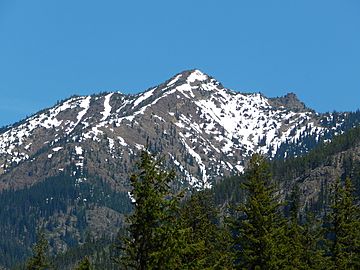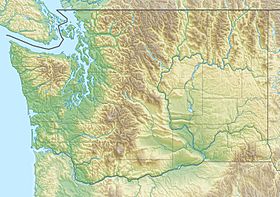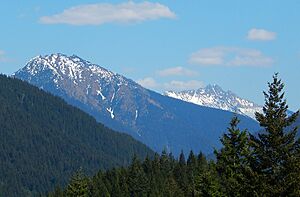McKay Ridge facts for kids
Quick facts for kids McKay Ridge |
|
|---|---|

McKay Ridge seen from East Creek Trail
|
|
| Highest point | |
| Elevation | 7,000+ ft (2,130+ m) |
| Prominence | 800 ft (240 m) |
| Geography | |
| Location | Whatcom County, Washington, U.S. |
| Parent range | North Cascades |
| Topo map | USGS Azurite Peak |
| Climbing | |
| Easiest route | Scrambling |
McKay Ridge is a tall mountain ridge in Whatcom County, Washington state. It stands about 7,000 feet (2,134 meters) high. This ridge is part of the Okanagan Range, which is a smaller part of the larger North Cascades mountains.
McKay Ridge is located north of the North Cascades Highway. It is on land managed by the Okanogan National Forest. The closest taller mountain is Majestic Mountain, which is about 1.6 miles (2.6 kilometers) to the northeast. Water from rain and melting snow on McKay Ridge flows into Ross Lake. This water then joins the Skagit River.
Contents
Weather at McKay Ridge
McKay Ridge is in a "marine west coast climate zone." This means it gets a lot of moisture from the Pacific Ocean. Most of the weather systems, like big clouds and storms, start over the Pacific Ocean. They then travel northeast towards the Cascade Range.
How Mountains Affect Weather
When these weather systems reach the North Cascades, the tall mountains force the air to rise. As the air goes higher, it cools down and drops its moisture. This moisture falls as rain or snowfall onto the mountains. This process is called orographic lift. Because of this, the western side of the North Cascades gets a lot of rain and snow, especially in winter.
During winter, the weather is often cloudy. But in summer, high pressure systems over the Pacific Ocean usually bring clear skies. Because the ocean influences the weather, the snow here tends to be wet and heavy. This can make the risk of avalanches higher.
How McKay Ridge Was Formed
The North Cascades area has very rugged land. It features sharp peaks, long ridges, and deep valleys carved by glaciers. The way the land looks today was shaped by huge geological events that happened millions of years ago. These events caused big changes in elevation, which led to different climates and types of plants in the area.
Ancient Earth Movements
The Cascade Range began forming millions of years ago, during a time called the late Eocene Epoch. This happened because the North American Plate (a huge piece of Earth's crust) was slowly moving over the Pacific Plate. This movement caused many volcanic eruptions. Also, smaller pieces of Earth's crust, called terranes, came together to form the North Cascades about 50 million years ago.
Ice Age Impact
Over two million years ago, during the Pleistocene period (also known as the Ice Age), glaciers repeatedly moved across the land. As they moved, they scraped away rock and left behind piles of debris. The river valleys in this area now have a "U" shape. This shape was created by these ancient glaciers. The combination of land being pushed up (called uplift) and cracks in the Earth's crust (called faulting), along with the glaciers, created the tall peaks and deep valleys we see in the North Cascades today.




